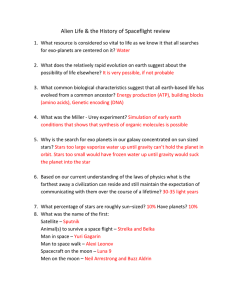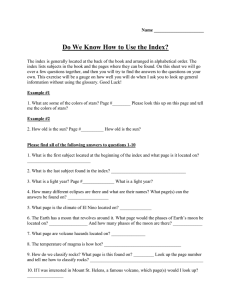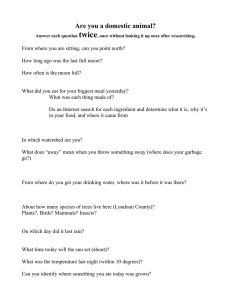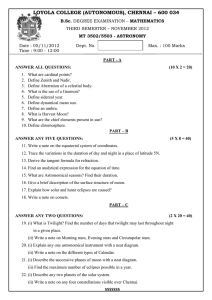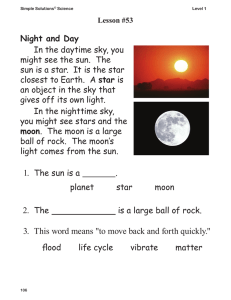Sun, mOOn, and StarS
advertisement
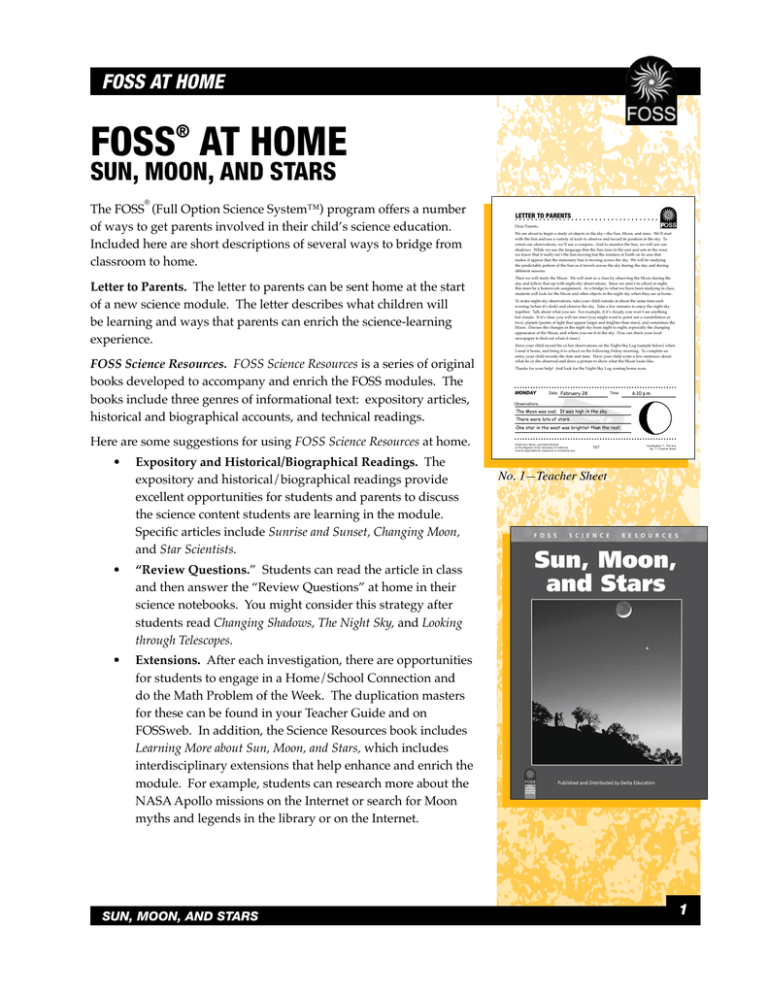
FOSS at Home FOSS® at Home Sun, Moon, and Stars ® The FOSS (Full Option Science System™) program offers a number of ways to get parents involved in their child’s science education. Included here are short descriptions of several ways to bridge from classroom to home. Letter to Parents. The letter to parents can be sent home at the start of a new science module. The letter describes what children will be learning and ways that parents can enrich the science-learning experience. FOSS Science Resources. FOSS Science Resources is a series of original books developed to accompany and enrich the FOSS modules. The books include three genres of informational text: expository articles, historical and biographical accounts, and technical readings. Here are some suggestions for using FOSS Science Resources at home. •• Expository and Historical/Biographical Readings. The expository and historical/biographical readings provide excellent opportunities for students and parents to discuss the science content students are learning in the module. Specific articles include Sunrise and Sunset, Changing Moon, and Star Scientists. LETTER TO PARENTS Dear Parents, We are about to begin a study of objects in the sky—the Sun, Moon, and stars. We’ll start with the Sun and use a variety of tools to observe and record its position in the sky. To orient our observations, we’ll use a compass. And to monitor the Sun, we will use our shadows. While we use the language that the Sun rises in the east and sets in the west, we know that it really isn’t the Sun moving but the rotation of Earth on its axis that makes it appear that the stationary Sun is moving across the sky. We will be studying the predictable pattern of the Sun as it travels across the sky during the day and during different seasons. Then we will study the Moon. We will start as a class by observing the Moon during the day and follow that up with night-sky observations. Since we aren’t in school at night, this must be a homework assignment. As a bridge to what we have been studying in class, students will look for the Moon and other objects in the night sky when they are at home. To make night-sky observations, take your child outside at about the same time each evening (when it’s dark) and observe the sky. Take a few minutes to enjoy the night sky together. Talk about what you see. For example, if it’s cloudy, you won’t see anything but clouds. If it’s clear, you will see stars (you might want to point out a constellation or two), planets (points of light that appear larger and brighter than stars), and sometimes the Moon. Discuss the changes in the night sky from night to night, especially the changing appearance of the Moon, and where you see it in the sky. (You can check your local newspaper to find out when it rises.) Have your child record his or her observations on the Night-Sky Log (sample below) when I send it home, and bring it to school on the following Friday morning. To complete an entry, your child records the date and time. Have your child write a few sentences about what he or she observed and draw a picture to show what the Moon looks like. Thanks for your help! And look for the Night-Sky Log coming home soon. MONDAY Date February 28 Observations Time 6:10 p.m. SAM The Moon was oval. It was high in the sky. There were lots of stars. PLE One star in the west was brighter than the rest. FOSS Sun, Moon, and Stars Module © The Regents of the University of California Can be duplicated for classroom or workshop use. 157 Investigation 1: The Sun No. 1—Teacher Sheet No. 1—Teacher Sheet •• “Review Questions.” Students can read the article in class and then answer the “Review Questions” at home in their science notebooks. You might consider this strategy after students read Changing Shadows, The Night Sky, and Looking through Telescopes. •• Extensions. After each investigation, there are opportunities for students to engage in a Home/School Connection and do the Math Problem of the Week. The duplication masters for these can be found in your Teacher Guide and on FOSSweb. In addition, the Science Resources book includes Learning More about Sun, Moon, and Stars, which includes interdisciplinary extensions that help enhance and enrich the module. For example, students can research more about the NASA Apollo missions on the Internet or search for Moon myths and legends in the library or on the Internet. Sun, Moon, and Stars 1 Sun, Moon, and stars HOME/SCHOOL CONNECTION INVESTIGATION 1: THE SUN 10 11 Sundial Pattern NOON 12 This sundial works best at 38° N latitude, the latitude of San Francisco Bay. 2 1 Materials • 1 9 3 1 • 1 b Directions 8 4 7 5 6 a.m. 6 p.m. a NORTH Sundial Fold tab under on dotted line. Tape to base. a Gnomon Cardboard (tagboard or file folder) Scissors or mat knife Protractor Glue and transparent tape Compass b FOSS Sun, Moon, and Stars Module © The Regents of the University of California Can be duplicated for classroom or workshop use. 1. Glue the pattern to a piece of cardboard. 2. Cut out the sundial and the gnomon. 3. Tape the gnomon tab to the sundial on the 12:00 line, matching points a and b. 4. Place the sundial on a level surface outside. Use a compass to help align the noon end of the sundial towards the North. You can fine-tune the sundial by comparing the time you see on the sundial to the time on a watch. If there is a difference, turn the sundial until the times most nearly match. When you get the sundial adjusted, you might want to mark the location with some chalk. When you place the sundial back in the same position, it should give you an accurate time. Investigation 1: The Sun No. 21—Teacher Sheet 177 No. 21—Teacher Sheet Name ____________________________________ Date ____________________________________ MATH EXTENSION—PROBLEM OF THE WEEK INVESTIGATION 2: THE MOON In a make-believe planetary system, three planets orbit a star. The closest planet is Alfar, the middle planet is Baytar, and the farthest from the star is Gammar. Planet Gammar orbits the star in 360 days. So the Gammar year is 360 days long. Baytar orbits in 240 days. Alfar orbits in 120 days. Baytar Orbit = 240 days Star Alfar Orbit = 120 days Gammar Orbit = 360 days One day the people of Gammar noticed that all three planets were lined up. 1. How many Gammar years will it be until the three planets line up again? Science Notebook Sheets. Throughout the module, students complete various recording and response sheets. Students should bring the sheets and/or their science notebooks home for families to review and discuss. In Investigation 2, students take home a NightSky Log after learning how to use it to record observations of the night sky, including the shape of the Moon. Students work with family members to record observations each of four consecutive nights and return the completed log to class on Friday. These observations are the first step to learning the pattern of the 4-week lunar cycle. Home/School Connections. Home/School Connections are activities developed specifically for the whole family to enjoy at home. For example, in Investigation 1 (Teacher sheet number 21), students can make a model sundial at home. The Home/School Connections can also be found in the FOSS Science Resources book. Interdisciplinary Extensions. Each investigation has suggestions for art, language, math, social studies, and science extensions. These are good family activities. For example, after Investigation 3 students can create simple constellation viewers from paper-towel tubes and paper. They might also do the Math Problem of the Week at home. Both the Math Problem of the Week and some interdisciplinary extensions can be found in the FOSS Science Resources book. FOSSweb (www.fossweb.com). FOSSweb is an interactive website where families can find instructional activities and interactive simulations specifically designed for each FOSS module. 2. How many orbits will Gammar make before they line up again? 3. How many orbits will Alfar and Baytar make? FOSS Sun, Moon, and Stars Module © The Regents of the University of California Can be duplicated for classroom or workshop use. 175 Investigation 2: The Sun No. 19—Teacher Sheet No. 19—Teacher Sheet NOTE: All student sheets, including the Letter to Parents and Home/ School Connections, are available in FOSS Teacher Guides and online at www.fossweb.com. They are also available in Spanish. See For Parents and Teachers: Home/ School Connection on page 4 of this folio. 2 NOTE: Pages 3 and 4 of this folio can be photocopied and sent home for parents to read. These pages provide information on the resources for students and their families on FOSSweb. full option science system FOSS at Home FOSSWEB (WWW.FOSSWEB.COM) The FOSS program maintains a resource-rich website for students and their families and friends. To explore the resources available for the Sun, Moon, and Stars Module, first enter www.fossweb.com in your browser. The FOSS website requires plug-ins for your browser. We recommend that you click the “Test Your Browser” link at the bottom of the home page before you begin to ensure your computer has the minimum requirements. Click the grades 3–6 icon to get a menu that links to each of the 3–6 modules. There you can choose Sun, Moon, and Stars and travel to a wealth of information and activities specific to this module. ACTIVITIES In the Sun, Moon, and Stars Module, you’ll find three activities: Lunar Calendar, Pacific Coast Sunsets, and Star Maps. Pacific Coast Sunsets should be introduced after students have completed Investigation 1: The Sun. This video collection of sunsets from Berkeley, California allows students to keep track of where and what time the Sun sets over a 6-month period. You might ask, •• What pattern do you notice? •• How can you explain the patterns? Lunar Calendar should be introduced after students have completed Investigation 2: The Moon. In this activity, you can see the phase of the Moon on any day in the modern period (1–3000 C.E.). Select the day, month, and year for the phase of the Moon by moving the slider and typing the year. Continuous mode will change the phase of the Moon as you change the date. Controlled mode will not change the phase of the Moon until you click the Show Me the Phase! button. Here’s an activity you can do at home: Try observing the Moon on your own. Every night at the same time, draw the Moon’s phase and indicate where it is in the sky. Some nights you won’t see the Moon. Do you know why? Star Maps should be introduced after students have completed Investigation 3: The Stars. You can view and download seasonal star maps to help you locate and identify objects in the night sky, such as stars, constellations, and planets. Choose the star map for the months you need. Take the map outside on a clear night, and hold and turn the map to match the location of the Big Dipper and the North Star. Sun, Moon, and Stars 3 Sun, Moon, and stars MEDIA The Media section includes a rich list of resources that can extend and enrich the concepts learned in the Sun, Moon, and Stars Module. Here is where you will find images, movies, audio stories, reading resources, and websites. Images and Movies The Images and Movies sections include pictures and movies that can enhance the concepts learned in the Sun, Moon, and Stars Module. Audio Stories This section contains audio recordings of the FOSS Science Resources book for the Sun, Moon, and Stars Module. At the Library This section includes an annotated list of books and videos recommended for the Sun, Moon, and Stars Module. You should be able to find many of these titles at your local library. Websites The Websites section includes links to sites that can extend and enrich children’s experiences with the Sun, Moon, and Stars Module. VOCABULARY In the Vocabulary section, you will find the glossary words and definitions used in the Sun, Moon, and Stars Module. They are provided in English and Spanish. For parents and teachers: Home/school connection The For Parents and Teachers section includes the Home/School Connection that describes ways for families to do science together. For example, in Investigation 2 (Teacher sheet number 22), families can discuss and explore using the Internet how each full Moon got its name. Look in this section for other resources included in a downloadable PDF file, including a general letter introducing the module and math extensions that relate to the science investigations. 4 Copyright The Regents of the University of California full option science system 1287875

